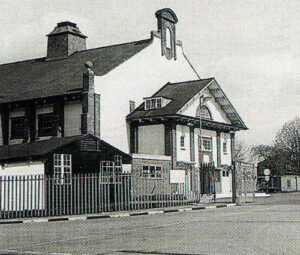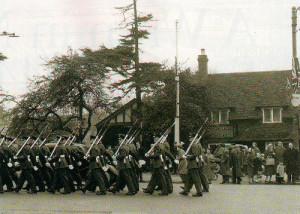
Apart from the visits by Charles I and Oliver Cromwell during the Civil War, Uxbridge’s main claim to fame is its RAF Station, as highlighted in Peter Kelly’s detailed account in a recent Best of British of the vital part it played in the Battle of Britain.
The site was originally a private estate known as Hillingdon House. It was acquired by the War Department in 1915 for use as a convalescent home for wounded Canadian soldiers, and later an Armament and Gunnery School for the Royal Flying Corps. RAF Uxbridge came into being when the RFC was re-named Royal Air Force in April 1918.
A new recruit in 1922 was Aircraftsman, John Ross, who underwent three months’ training there. His real name was T E
Lawrence – better known as Lawrence of Arabia. Later, when asked why he had enlisted in the ranks, he replied that he wanted to do penance for such a rich life. His book The Mint chronicles his stay at Uxbridge.
I lived near the camp, and my first visits were in the carefree, pre-war days when its gates were open to civilians at any time. A schoolmate’s parents lived in the married quarters, and we spent many happy hours in what was virtually an adventure playground. With the narrow River Pinn meandering through wooded glades of wild flowers, it resembled a country park rather than a military barracks, and the route from the St. Andrew’s Gate off the High Street to the Hillingdon exit provided a popular walk for local residents.
On Saturdays, we watched Uxbridge Football Club play at the RAF Stadium. The club had used the ground since 1923, and apart from the war years, played there until 1948. The stadium hosted representative matches and athletic events, and LAC MacDonald Bailey (third in the 100 metres at the 1952 Olympics in Helsinki) competed there along with many famous athletes. A giant scoreboard stood opposite the main stand, and on Uxbridge match days hordes of youngsters clung to it to get a better view.
Eventually, we could afford to sit in the stand – for an extra threepence.
Entertainment was also provided by the Camp Cinema which had opened to the public in 1919. The Saturday afternoon matinee price for children was threepence, a penny cheaper than the other cinemas. Seating was basic – all on one level – and the films were old, but I saw The Plainsman, and A Christmas Carol, which I’d been too young to see previously. The cinema also doubled as a gymnasium and venue for boxing tournaments.

When war came, the main gates and cinema were closed to civilians, and Uxbridge FC was without a ground. And as graphically described in Peter’s article, the station’s finest hour was fast approaching. Building work on the underground operations centre had begun in 1937, and was completed in August 1939. While many bombs fell around the outskirts, the camp remained unscathed, although in September 1940 a land mine dropped into a tree only 50 yards from the entrance to the bunker. The mine was removed and safely defused.
Apart from Churchill and the King and Queen, another distinguished visitor to the
operations room was General de Gaulle. A guard of honour was paraded for the General, but apparently he was too busy to inspect them. Doubtless the waiting airmen didn’t think the entente was as cordiale as it might have been!
Incidentally, when Churchill left the sta-
tion with Lord Ismay on August 16 1940, he uttered those now famous words “Never in the field…etc.” and repeated than in his speech to the Commons four days later.
Throughout the war the town was full of airmen – many of whom dated local girls and provided strong opposition to local lads who were at a disadvantage with the uniformed ‘Brylcreem boys’. Among them, wounded men in distinctive light blue uniforms, white shirts and red ties could often be seen, as the camp had a big hospital.
On days when airmen were shipped out en bloc, a convoy of youngsters would be in tow, wheeling the men’s kitbags in home
made barrows (orange boxes on pram wheels). On arrival at the railway stations, the boys received a tip of at least sixpence.
RAF Uxbridge has been alive with the sound of music since the Central Band took up residence in 1920. Despite heavy commitments, they performed for civic ceremonies, Armistice Day services and local church parades every Sunday – followed by an hour’s concert in the Camp Cinema, to which the public was admitted free. And in June 1938, they played at the opening of the Odeon Cinema.
1940 saw the formation of the RAF Dance Orchestra (The Squadronaires). Led by Sgt. Jimmy Miller, their line-up included trumpeters Kenny Baker and Tommy McQuater, trombonist George Chisholm, pianist Ronnie Aldrich (whose children attended my school) and clarinettist Andy McDevitt, who was billeted with a classmate of mine. Their busy schedules included BBC broadcasts, tours of variety theatres and charity concerts, two of which I attended at our Odeon. Uxbridge also formed the RAF Symphony Orchestra comprising many well-known musicians -among them the dance band leader Cyril Stapleton.
The RAF has always enjoyed an excellent relationship with the town and played an active part in its history, and in 1960 Uxbridge showed its appreciation by presenting the Service with the ‘Freedom of Entry into the Borough.’ That meant they were granted “the privilege and honour, henceforth and forever, of marching through the streets of Uxbridge on all ceremonial occasions with drums beating, colours flying, swords drawn and bayonets fixed.”
And this they continue to this day!
James Skinner








